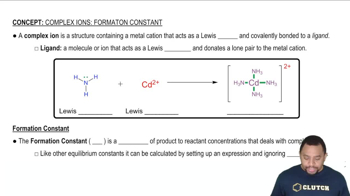Here are the essential concepts you must grasp in order to answer the question correctly.
Ion Selectivity
Ion selectivity refers to the ability to separate specific ions from a mixture based on their unique chemical properties. This can be achieved through various methods, such as precipitation, complexation, or selective adsorption. Understanding the differences in solubility, charge, and reactivity of ions is crucial for designing effective separation strategies.
Recommended video:
Precipitation Reactions
Precipitation reactions occur when two soluble salts react to form an insoluble compound, or precipitate. This process is often used to separate ions in solution. For example, adding a reagent that forms a precipitate with one ion while leaving the other in solution can effectively separate them, making it a key technique in ion separation.
Recommended video:
Complex Ion Formation
Complex ion formation involves the interaction of metal ions with ligands to form a stable complex. This can alter the solubility and reactivity of the metal ions, allowing for selective separation. By introducing a ligand that preferentially binds to one of the ions, it can be effectively separated from the other ion in the mixture.
Recommended video:
Complex Ions and Formation Constant

 Verified step by step guidance
Verified step by step guidance


